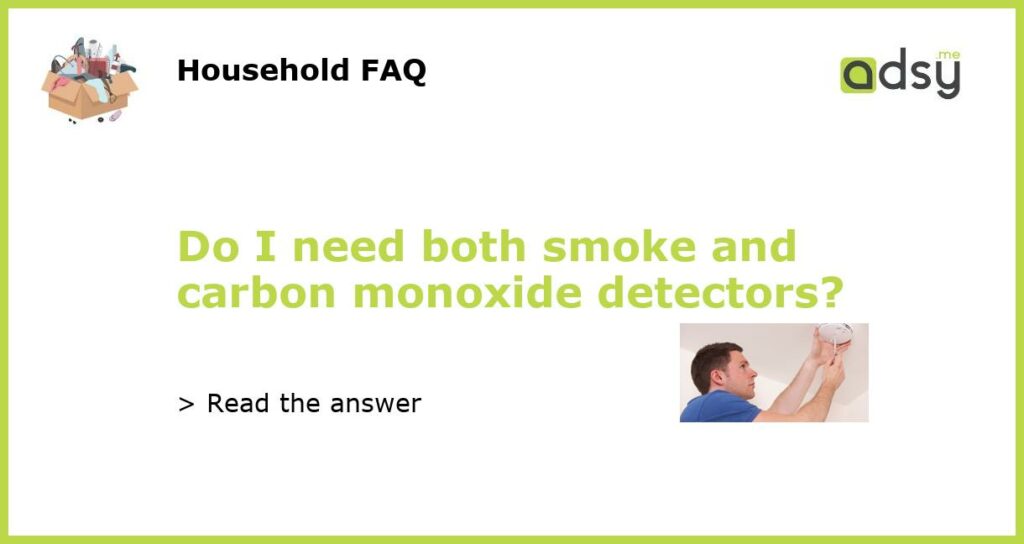Yes, You Need Both Smoke and Carbon Monoxide Detectors
If you’re concerned about safety in your home, it’s important to have both smoke and carbon monoxide detectors. These two devices serve different purposes and are designed to detect different types of hazards. While smoke detectors are essential for detecting fires, carbon monoxide detectors are necessary for detecting the presence of this silent and deadly gas. Here’s why you need both.
Smoke Detectors: Alerting You to the Presence of Fire
Smoke detectors are the first line of defense in case of a fire. They are designed to detect the presence of smoke in the air, signaling that a fire has ignited. Smoke detectors use either ionization or photoelectric sensing technology to detect the tiny smoke particles that are produced during a fire. Once smoke is detected, the alarm will sound, giving you and your family enough time to escape to safety or extinguish the fire if it’s still small.
House fires can spread rapidly, engulfing your property within minutes. Having a smoke detector installed in every bedroom, hallway, and common area of your home can significantly increase your chances of detecting a fire early and taking appropriate action. According to the National Fire Protection Association (NFPA), three out of five home fire deaths occurred in homes without working smoke detectors.
Carbon Monoxide Detectors: Preventing Silent Poisoning
Carbon monoxide (CO) is a colorless, odorless gas that can be lethal when inhaled in high concentrations. It is produced by the incomplete burning of fuels such as gas, oil, coal, wood, and propane. Carbon monoxide can build up in your home if there are faulty appliances, blocked vents, or poor ventilation. Without a detector, you may not realize that you’re being exposed to this dangerous gas until it’s too late.
Carbon monoxide detectors are designed to detect the presence of CO in the air, similar to smoke detectors. They use different sensing technologies, such as electrochemical or metal oxide sensors, to measure the levels of carbon monoxide in your home. If the concentration exceeds a certain threshold, the alarm will sound, alerting you to the potential danger.
The Dangers of Carbon Monoxide Poisoning
Carbon monoxide poisoning is a serious and potentially deadly condition. When you inhale carbon monoxide, it replaces oxygen in your bloodstream and deprives your vital organs of the oxygen they need to function properly. Early symptoms of carbon monoxide poisoning can mimic flu-like symptoms, such as headaches, dizziness, nausea, and confusion. Prolonged exposure to high levels of carbon monoxide can lead to loss of consciousness, brain damage, and even death.
To prevent carbon monoxide poisoning, it’s important to have carbon monoxide detectors installed near sleeping areas and on every level of your home. This is especially important if you use fuel-burning appliances or have an attached garage. According to the Centers for Disease Control and Prevention (CDC), more than 10,000 people in the United States are hospitalized for carbon monoxide poisoning each year, with an estimated 430 deaths.
The Importance of Having Both Detectors
To ensure the safety of your home and everyone in it, it’s crucial to have both smoke and carbon monoxide detectors installed. Smoke detectors are essential for alerting you to the presence of a fire, giving you the time needed to escape or extinguish it. Carbon monoxide detectors, on the other hand, are crucial for detecting the presence of this deadly gas, which is impossible to detect without specialized equipment.
By having both detectors, you can significantly reduce the risks associated with fires and carbon monoxide poisoning. Make sure to test your detectors regularly, replace the batteries as needed, and replace the units every 10 years or as recommended by the manufacturer. Your safety and the safety of your loved ones depend on it.

